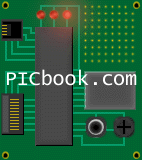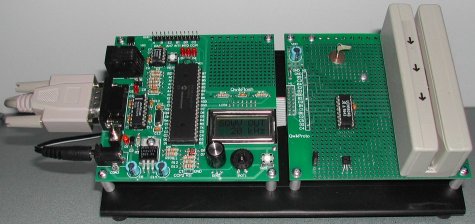

The QwikFlash devlopment board is used as an example in the book for interfacing the PIC18F452 to various external components. The board contains varous I/O devices such as an RS-232 port (for program code development with QwikBug), RPG, potentiometer,a pushbutton, an LCD, and a few LEDs. A temperature sensor is included on the board to demonstrate the use of the PIC18F452's A/D module. A two-channel D/A converter illustrates the use of the PIC18F452's SPI three-wire interface. A prototyping section is included to add functionality to the board. Additional components can also be added by chaining a QwikProto board to the QwikFlash board via the SPI / I2C bus (and a few unused I/O pins) as depicted below.
The figure above depicts the target system used in our Embedded Microcontroller Design course at Georgia Tech. Here the QwikFlash board has been chained to a QwikProto board which has been equipped with a magnetic card reader, a stepper motor, and a temperature sensor having a PWM output.
Assembled and tested QwikFlash boards, QwikProto boards, QwikBreadboards, stands, and PIC18F452 parts pre-programmed with QwikBug, everything needed to set up a microcontroller laboratory, can be purchased at MICRODESIGNS, INC.!
02/08/2003 |

